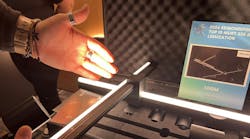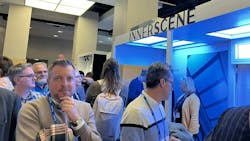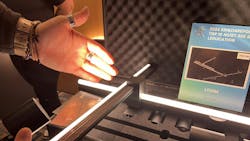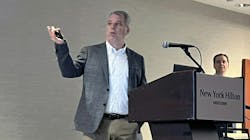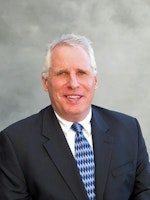LEDucation built on its growing reputation as a national lighting show with estimated attendance of nearly 11,000 and an as-yet undetermined final count of participants in virtual training sessions at the New York Hilton Hotel on March 19-20.
Well over 400 booths and 48 educational sessions attracted members of the lighting community from across the United States. For the 475 exhibitors, a major attraction of the event was that all booths were restricted in size, trimming the comparatively large investment of a booth at LightFair. According to a report at inside.lighting.com, each individual booth was limited to 224 cubic feet, with standard dimensions of 7 ft in width, 4 ft, in depth and 8 ft in height. Many exhibitors used the smaller footprint to focus on a tightly targeted selection of product launches — often less than five new products.
Although it has evolved into a national show, LEDucation has a distinctly New York City feel. On the first day of the event, some of the aisles in the four exhibition halls were jammed to the point of gridlock. It almost seemed like the event was a victim of its own success, with some aisles at times almost completely blocked by attendees visiting with vendors and chatting with business associates. Printer glitches on Day 1 at the registration kiosks added to the general atmosphere of controlled mayhem. On Day 2, the show aisles on the trade show floor were much easier to navigate, and registration seemed to be a breeze.
A surprising number of lighting vendors were exhibiting tape lighting at LEDucation, which has become popular because of the broad array of colors LEDs now offer and the customization/flexibility the products provide. At the Tivoli Lighting booth, Larry Lin differentiated his company’s tape light by demonstrating available color temperatures and other technical characteristics in a notebook with “live lighting.”
The trend toward fixture miniaturization was also evident, with many fixtures of less than 2 in. on display that provide better lighting than the PAR lamp options available a few years ago. WAC Lighting has launched many smaller track luminaires with impressive lighting specs over the past few years, and this design trend was also evident in its new Colorscaping landscape lighting products. They use conventional two-wire landscape lighting to provide tunable white light from 2,700K to 6,500K. Fixture beam spreads are adjustable on site, and the lighting scenes can be controlled via an intuitive app.
Edison Price’s Loom track lighting system also uses smaller fixtures that pack a punch. Loom allows lighting pros to quickly adjust fixture placement along a sliding rail system. The product was one of the Edison Report’s “Top 10 Must See Products” at LEDucation.
Innerscene had a particularly busy booth during both days of the show. Innerscene’s Virtual Sun is a skylight that mimics the light of the sun or as it tracks across the sky with simulated circadian rhythms.
A big part of the LEDucation experience is the event’s impressive offering of on-site and virtual training. Leviton’s Joe Brisco, technical sales specialist, and ConTech’s Mike Lehman, general manager, helped a packed room of lighting designers and other show attendees understand the nuances of the many code updates for IECC and ASHRAE 90.1 lighting and control requirements. States and cities have adopted different versions of these building and design codes, so it’s important to check with your local inspectors on what version your market area is following.
In the “POE Past-Present-Future” panel discussion, Mitchell Bloomberg, International Lights; Lilian Fu, WSP; Farukh Aslam, Sinclair Holdings; and Michael Baudo, Zumtobel, updated the audience on the use of DC power in Power over Ethernet (PoE) lighting and other building applications. At Sinclair Holdings, Aslam has been using DC power in hotels and several other large commercial applications and is a big believer in its potential to provide dependable power at a much lower installation cost than traditional wiring because of the use of smaller wire and cable — and the fact that it can be installed without conduit.
LEDucation continues to resonate with lighting professionals for several reasons. It’s an event managed by New York’s lighting designers and lighting reps, so it has a “by the people, for the people” feel.
The continuing march of lighting technology continues to fuel interest in the event, too. It’s getting tough to squeeze additional energy savings out of LED lighting systems because of the revolutionary R&D we have seen with LED technology, and the dramatic savings over the past two decades LEDs have been on the scene. But with fixture miniaturization and other innovative new fixture form factors, advancements in app-based and wireless lighting control, and the potential of PoE lighting, there’s still plenty of new products in the pipeline.
The next generation of LED lighting systems will be on display at LEDucation 2025, which will be back at the New York Hilton on March 18–19, 2025.
